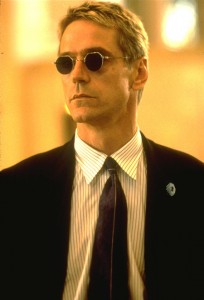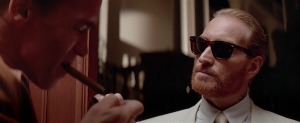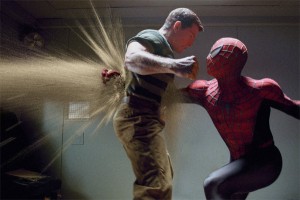Villains are great, aren’t they? Everyone has a favourite from Darth Vader to Freddy Kruger, but what about those villains who got side-lined either because they starred in the wrong film or they got over shone by some upstart other villain?
I pay tribute to them.
The Film:
Last Action Hero
The Villain:
Benedict (Charles Dance)
Why they’re unappreciated:
Last Action Hero is often viewed as one of the great misfires Arnold Schwarzenegger’s filmography. Whilst this isn’t entirely fair the film is in no way as well regarded as films such as Commando or Predator or Conan the Barbarian. As such Charles Dance’s glorious villainous turn often gets forgotten.
Why they’re great:
Because Charles Dance is having the time of his life in the film.
Schwarzenegger had had an amazing array of villains played by an amazing array of actors. He’s worked his way through such villainous luminaries as Ronny Cox, Michael Ironside, Robert Patrick, James Earl Jones, James Caan, Art Malik and Vernon Wells. Simply put if you were a character actor in the eighties or nineties Schwarzenegger probably made a pun as he crushed your trachea.
Charles Dance was a natural fit into this list of doomed thespians but for whatever reason his glorious performance was smothered by the lukewarm reaction to the film. Dance plays Benedict as if we’re seeing his time between scenes. A general air of dissatisfaction and listlessness sort of runs through the character and his frustration at his employer, who thinks only as movie villain, is kind of hilarious. It also means that when he finally breaks free of the film reality he delivers a genuinely joyful performance. He’s like a kid at Christmas when he realizes that in the real world apathy reigns supreme.
Benedict benefits both from the heightened movie reality found in the first two acts of Last Action Hero and the more realistic third act. His deadpan snark and inexplicable fetish for explosions making him a great colourful antagonist and his interactions in the real world making him oddly relatable.
Great Villainous Moment:
“I’ve just shot somebody, I did it on purpose.”

"Simon Says sit down and watch Eragon or I'll blow up a school" "Y'know what, I don't even like kids that much"
The Film:
Die Hard with a Vengeance
The Villain:
Simon Gruber (Jeremy Irons)
Why they’re underappreciated:
Because he’s Hans Gruber’s little brother and he’s consistently in the shadow of one of the most iconic villains of the 1980s. Following on from Alan Rickman is always going to be difficult, the man is a national treasure after all, but following on from Alan Rickman in the second sequel to one of the most beloved action films ever made is difficult. That’s the thing with Die Hard with a Vengeance, it’s a perfectly fine film but the collective geek memory seems to omit the Die Hard sequels as a way of preserving the integrity of the original. You can make a case for Die Hard with a Vengeance but the factual response will always be ‘Yeah, but it’s not as good as the original’. It’s akin to Theologians trying to explain why Jesus totally not caring about a stubbed toe is somehow a worthy follow up to his resurrection. Which is a shame because Die Hard with a Vengeance is actually a kind of great film and stubbed toes totally hurt, especially when you’re wearing sandals.
Why they’re great:
Because despite how largely the same arc as his brother, Simon is perhaps a more worthy foil for John McClane. Hans Gruber is a character with a distinct plan which is ruined consistently by McClane; they’re nemesis by accident rather than by design. Simon meanwhile takes on McClane in a head-on way and the interplay between the two is fascinating. Simon essentially reflects on the weaknesses of McClane in the way that McClane revealed weaknesses within Hans. Simon is also more brutal than Hans but less overly bloodthirsty. One of the weird things about Die Hard is that you kind of end up rooting for Has and co. despite the fact that their plan essentially involves the murder of dozens of innocent people. Well, they’re 80s yuppies…but they’re still kind of people. Simon instead relies on misdirection using far more force than Hans when needed but also showcasing at least a little humanity. The inferred crimes of Hans are more heinous than the witnessed crimes of Simon.
Part of the reason for the strength of Simon’s character comes from the fact that the film was originally designed as a standalone project, only getting converted into a piece of the Die Hard process at the last moment. As such Simon is the conceptual heart of the film and Irons plays his role like he’s the star of the piece. Bristling with energy and hiding a more violent streak than his brother under a façade of amicability Simon’s taunting of McClane and overall scheme is the main plot driver, with McClane forced to react to Simon’s game throughout the film.
Great Villainous Moment:
Simon enters the Federal Reserve Bank playing the role of a City Engineer. At this point Irons is a Brit, playing a German, playing a Brit, playing an American and completely oversells his performance.
“Holy Toledo! Somebody had fun.”
The Film:
Hellraiser
The Villain:
Julia (Claire Higgins)
Why they’re underappreciated:
In Hellraiser the Cenobites are for the most parts arbiters rather than antagonists. They exist according to their own rules and only exhibit overly villainous tendencies towards the end. Their villainous turn is jarring because the central villainous dynamic of the majority of the film has been Julia and Frank Cotton, a pair of star crossed lovers murdering to be together again. Julia and Frank are the dark heart of the film, the catalyst for the main plot and antagonists towards Kirsty, the heroine of the piece. However the Cenobites would garner the most attention and their leader, at the time unnamed, would become the figurehead of the franchise.
The gothic fairy-tale of the original replaced by traditional slasher values and Julia’s fantastically wicked stepmother forgotten in Pinhead’s wake.
Why they’re great:
Because Julia is pure malevolence, malevolence not fuelled by hate but by apathy and past mistakes. Her attempts to rescue her former lover, Frank, the brother of her husband force her to do horrific things and she accepts these horrors. Despite her moment of initial hesitation her sociopathy wins out and soon she becomes as brutal and sadistic as her now restored lover. She’s a fascinating, if horrific, character and this is largely because Claire Higgins gives shading and depth to a character that could easily have been singular in her intent. Higgins makes you believe in the passion for Frank and unhappiness of her marriage and makes you understand, but never condone, even her most violent actions.
Higgins also knows when to go big and broad and the end of the film has her metamorphosis into an almost fairy-tale representation of the wicked stepmother. By the end she is practically Maleficent come to life. Julia also features in the Hellraiser sequel and despite being the major antagonist again she is overshadowed by the returning Cenobites and new villain Dr. Channard. Channard, played by a gloriously hammy Kenneth Cranham, should in theory have been an equal to Julia but ends up eclipsing her due to his insanely broad performance.
Great Villainous Moment:
Julia’s first murder is a great example of how amazing Claire Higgins’ performance is. Her disaffected seduction of her victim giving way to steely determination, horror and finally acceptance of the violence required to bring her lover back.
The Film:
Spider-Man 3
The Villain:
Sandman (Thomas Haden Church)
Why they’re underappreciated:
Because
- Everyone kind of hates Spider-Man 3
- The main antagonist of the film is a character that only shows up in the last thirty minutes.
- Sandman literally disappears for an hour of the film and barely features in it after that.
Why they’re great:
Because you can tell that Sam Raimi cares so much more about Sandman than the main villain of the film Venom. One of my main issues with Spider-Man 3 is that it’s so obvious Raimi has no clue what to do with Venom and it’s apparent in everything from his half-assed introduction to his one major action sequence.
One of the things I kind of dislike about Superhero films is that these films about super powered individuals usually end up with the hero and the villain just punching each other. Even the X-Men films, with a wealth of superpowers and characters, tend to have the major action sequences just be brawls. The Spider-Man films still had Spidey punching the crap out of the major villain, but the use of vertical space set them apart. Fights in Spider-Man 1 and 2 zigzagged across the screen, going in, around, and through the New York skyline. They were fights which felt unique and often told their own story. Sandman in Spider-Man 3 is fascinating because Raimi frames his action sequences with all the care and attention he had furnished onto The Green Goblin and Dr. Octopus in the previous films. Sandman’s initially robbery is filled with great moments and the drag out brawl with Spider-Man that sees the character disappear for about an hour is full of inventive moments and great uses of Sandman’s new condition. Because Sandman is made of sand Raimi is able to get away with Spider-Man being increasingly brutal in his treatment. In comparison the final fight with Venom barely tells you anything about either character and is handled with barely any aplomb.
Thomas Haden Church possibly plays the character a little too sympathetic, his big eyes and ambiguously dying child bringing to mind a man shaped Labrador rather than an engaging threat. Goblin and Octopus were conflicted characters but they were also aggressive, Church focused perhaps too much on the conflict and less on being an engaging opponent. However if Sandman had been the sole villain of the piece it’s easy to see him becoming increasingly antagonistic.
Great Villainous Moment:
The initial transformation sequence which is beautifully scored by Christopher Young and amazingly realised by the animators and the mo-cap actor. The few minutes spent watching the birth of the villain tell us more about the motivations and desires of the villain than the thirty minutes Topher Grace spends expositioning as Venom.


